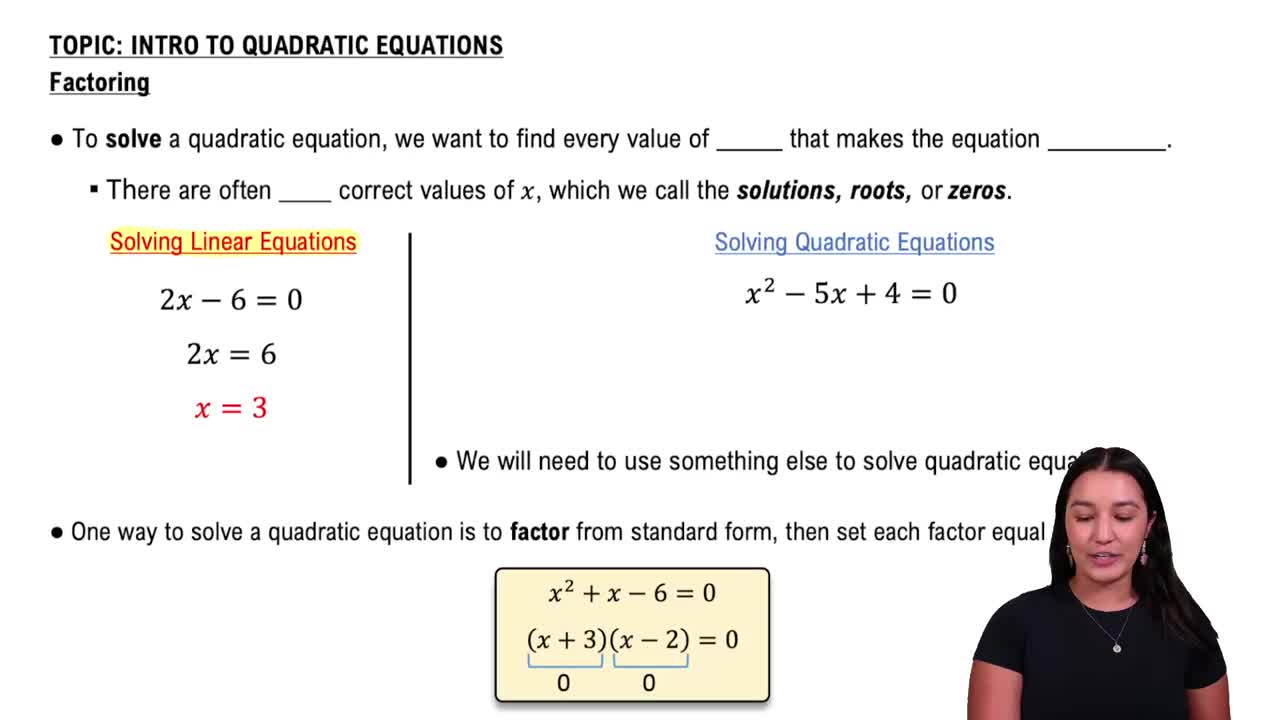Table of contents
- 0. Review of Algebra4h 16m
- 1. Equations & Inequalities3h 18m
- 2. Graphs of Equations43m
- 3. Functions2h 17m
- 4. Polynomial Functions1h 44m
- 5. Rational Functions1h 23m
- 6. Exponential & Logarithmic Functions2h 28m
- 7. Systems of Equations & Matrices4h 6m
- 8. Conic Sections2h 23m
- 9. Sequences, Series, & Induction1h 19m
- 10. Combinatorics & Probability1h 45m
1. Equations & Inequalities
Intro to Quadratic Equations
Problem 48
Textbook Question
Solve each equation using completing the square. See Examples 3 and 4. 3x^2 - 9x + 7 = 0
 Verified step by step guidance
Verified step by step guidance1
<Step 1: Start by moving the constant term to the other side of the equation.> \[ 3x^2 - 9x = -7 \]
<Step 2: Factor out the coefficient of the quadratic term from the left side.> \[ 3(x^2 - 3x) = -7 \]
<Step 3: Complete the square inside the parentheses. Take half of the coefficient of \(x\), square it, and add it inside the parentheses. Remember to balance the equation by adding the same value multiplied by the factored coefficient to the other side.> \[ 3(x^2 - 3x + \left(\frac{-3}{2}\right)^2) = -7 + 3\left(\frac{-3}{2}\right)^2 \]
<Step 4: Simplify the equation. The left side becomes a perfect square trinomial.> \[ 3(x - \frac{3}{2})^2 = -7 + \frac{27}{4} \]
<Step 5: Solve for \(x\) by isolating the perfect square and taking the square root of both sides.>
Recommended similar problem, with video answer:
 Verified Solution
Verified SolutionThis video solution was recommended by our tutors as helpful for the problem above
Video duration:
4mPlay a video:
Was this helpful?
Key Concepts
Here are the essential concepts you must grasp in order to answer the question correctly.
Completing the Square
Completing the square is a method used to solve quadratic equations by transforming the equation into a perfect square trinomial. This involves rearranging the equation and adding a specific value to both sides to create a square of a binomial. This technique simplifies the process of finding the roots of the equation, making it easier to solve for the variable.
Recommended video:

Solving Quadratic Equations by Completing the Square
Quadratic Equations
A quadratic equation is a polynomial equation of the form ax^2 + bx + c = 0, where a, b, and c are constants, and a ≠ 0. The solutions to these equations can be found using various methods, including factoring, using the quadratic formula, or completing the square. Understanding the standard form of a quadratic equation is essential for applying these methods effectively.
Recommended video:

Introduction to Quadratic Equations
Discriminant
The discriminant is a component of the quadratic formula, given by the expression b^2 - 4ac. It determines the nature of the roots of a quadratic equation: if the discriminant is positive, there are two distinct real roots; if it is zero, there is one real root (a repeated root); and if it is negative, there are two complex roots. Analyzing the discriminant helps in understanding the solutions' characteristics before solving the equation.
Recommended video:

The Discriminant

 5:35m
5:35mWatch next
Master Introduction to Quadratic Equations with a bite sized video explanation from Callie
Start learningRelated Videos
Related Practice










